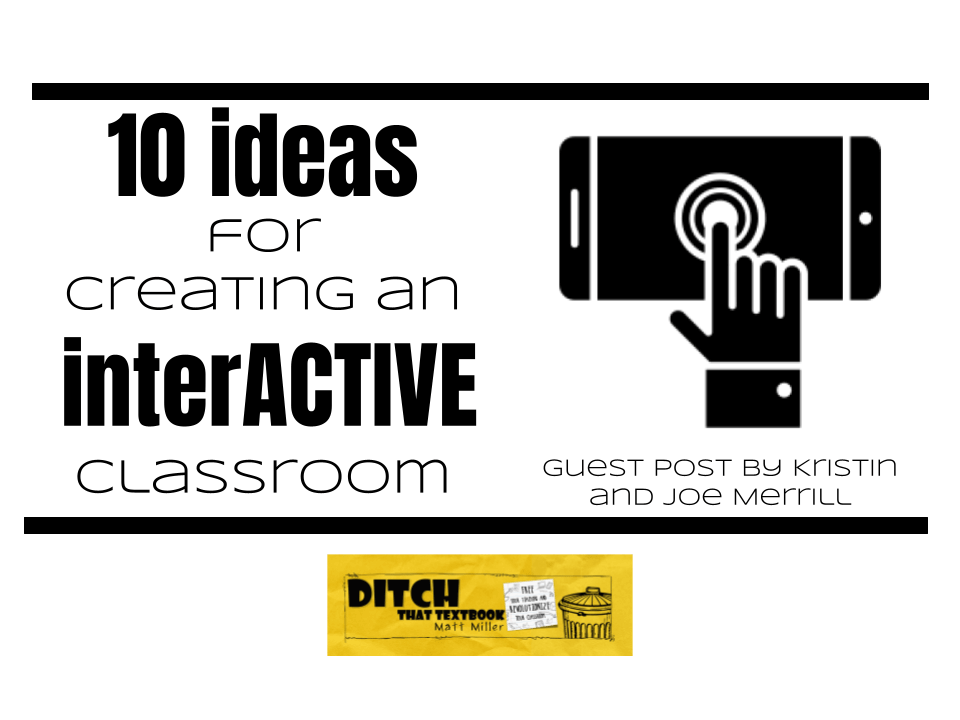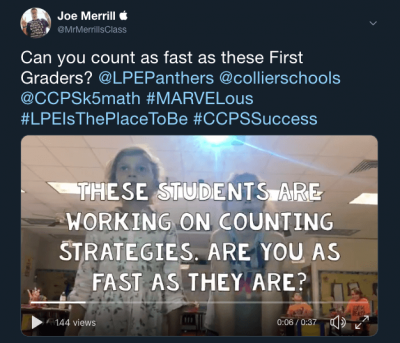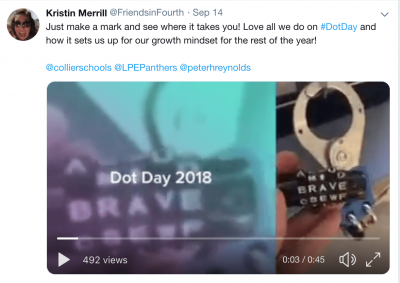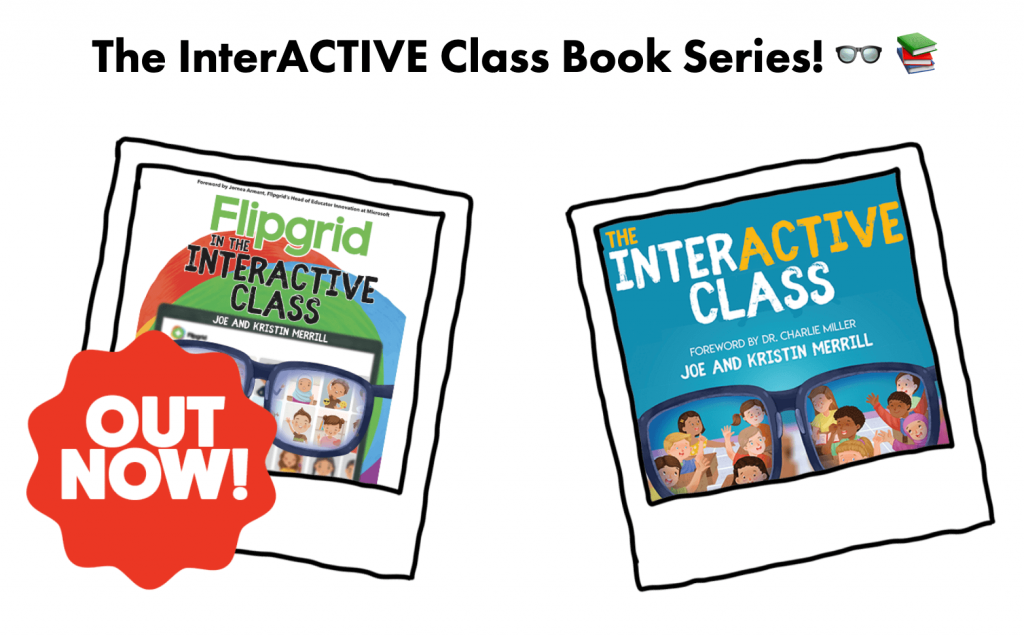This post is written by Joe and Kristin Merrill. Kristin is a fourth grade teacher, and Joe is a first grade teacher. They would love to stay connected with you! Follow them on Twitter at: @FriendsInFourth (Kristin), @MrMerrillsClass (Joe), and @TheMerrillsEdu (collectively). To gain access to free templates for the activities above, sign up for their mailing list at: www.themerrillsedu.com. Follow along with even more using the hashtag #interACTIVEclass.
Gen Z and Alpha Gen students are here. Is your classroom ready? Their brains are wired differently, so most of them have difficulty relating to the material being delivered.
Students today are all too often being forced into a traditional model of schooling that is no longer relevant to them. So, how can we be better?
The answer comes not so much in WHAT we teacher but HOW we teach. If we want these students to be successful in our classrooms, we need to figure out who they are, what they want to learn about and how they communicate.
This new generation of students take information in instantly and they lose interest fast. These students actually function better when their learning incorporates information from a variety of sources simultaneously. They know they can find information instantly simply by calling on their friends Alexa or Siri. So we as teachers must focus more on how we have our students interacting with content.
Our instruction can’t just be delivered systematically. It’s time for a change. We need to provide opportunities for our students to interact with the information.
The definition of interaction is the ability to be responsive or being sensitive, reflexive and receptive to something. When it comes to the relationships you have with your students how sensitive are you? When you are building lessons for your students how receptive are you to hearing their opinions and valuing their desire to learn in a specific way?
We as teachers need to start including a variety of techniques when it comes to reaching students and creating a truly interACTIVE class.
So, where do we start? Collaborative work, project-based learning, guided learning, and student-centered activities are all great ways to foster engagement and create an environment that meets the needs of all students. It’s important to provide a clear focus of the long-term goals and expectations and embed a space for student voice.
Here are 10 ways to create a truly interACTIVE class.
1. Lightning Problems
An interACTIVE lesson doesn’t always have to involve technology and lighting problems are a great example of this. This activity is great for any type of content that needs reviewing--vocabulary terms, math concepts, date and events in history---really the sky’s the limit. Have a slideshow with questions prepared ahead of time and have two students stand up together. Have one date, event, vocabulary definition, math problem etc. appear on the board, and then students are to answer “fast as lightning!” Rounds take only seconds and you have multiple students up and engaging with content.
Take a look here, and download a free template here! A simple lighting bolt on the board could signify some friendly competition the next day and really motivate your students to get studying. Get your kids up and interactive with content today!
2. Breakout boxes
Escape rooms are all the rage and what better than to bring them to your classroom. There are several ways to create breakout experiences for students that will help foster interACTIVE lessons. The most well known way to bring break out lessons to students is through the BreakoutEDU platform. You can purchase various boxes with over 15+ locks and tools like UV pens and black light flashlights. You also can gain access to digital breakout games as well as their digital game builder. But if you are wishing to create the break out experience without the subscription there are simple ways to add a little mystery and puzzle solving to your lessons. Invisible black light pens can be purchased for around $5 and can be used to create puzzles and codes embedded into content you already teach from.
For more information on BreakoutEDU head here!
3. Book QR codes
Now QR codes have been a favorite of teachers for years, and there are so many educational tools and programs that will generate them for you. If not, you can always create them on your own through a site like QRstuff.com. Now, imagine taking these QR codes and placing them throughout material you already are reading--a textbook, novel or class magazine. Create discussion questions and activities using tools like Classkick, Nearpod, Flipgrid and so many more and when students read up to that page or section they now have a way to engage and interact with the text. You can do this with text both short and long, and it is a great way to see where students are in the reading as well as giving you as the teacher a more engaging way to gauge their comprehension and understanding. To see how this works in action, click on the GIF below.
4. Nearpod Writing Centers
Nearpod is one of the favorite tech tools we have in our Tech Toolbox. Nearpod allows you to create online lessons by uploading your old material (pdfs, jpegs, ppts) while also adding interactive features such as Virtual Field Trips, 3D Objects, Quizzes, Polls, Open Ended Questions + more! One great feature included in Nearpod are their VR field trips. From within the four walls of the classroom, students can be transported to places like the Statue of Liberty, the Tower of London and Stonehenge! While exploring through the lesson, students are asked about their prior knowledge regarding the place, asked to record questions and observations, and there is even an embedded video at the end! Now, take it a step further and have them write about it! Maybe you are currently studying a unit about early immigrants and students have to write as if they were one of the many crowded on a boat headed towards the American shore line describing their feelings when the lady’s beautiful statue comes into view. This lesson can be adapted for littles in first grade thru high school depending on the scaffolding or complexity of the task that follows. Here’s a free template that @MrMerrillsClass uses with his first graders, and here’s a link to the Christmas Tree farm lesson (pictured below)!
5. Let the Dice Decide
Start with a set of questions--for this lesson the more the better. You know you have those times where there is an obligatory packet to go through or a set of questions to review prior to a big test. Take these questions and read them aloud one by one as responses in the Flipgrid topic. (For more information on free Edtech tool Flipgrid and how to set up a free account, click here!) Once your videos are set up, it is time to give students several dice which they can use to roll and add to find a sum. The number they roll equals the question they are to answer. (*If a student rolls the same number twice they can respond to another students answer instead of posting twice.) Students are still completing the curricular assignment, but the uncertainty of the dice creates and instant--yet simple--form of engagement.
6. Steve Spangler Science Experiments
Steve Spangler’s website is full of engaging activities that require minimal materials. In fact, most of the experiments use items that you most likely have around your home or classroom. You can find a list of experiments by clicking here. These interACTIVE activities include one of our favorite experiments to date: The Soda Can Challenge. Students learn all about how air pressure can cause a soda can to jump from one coffee mug to the next. Check it out below!
You’ve heard of the water bottle flip challenge, but meet the all new soda can challenge! 😳🤭💯
— Joe Merrill 👓 #interACTIVEclass (@MrMerrillsClass) January 27, 2020
Learning about force and motion, and how gravity impacts everything! ☕️ ⬇️#interACTIVEclass #K2SciChat #FLedChat #1stChat pic.twitter.com/sDIce2Z0lz
7. Math Dice
A set of dice is an absolute must have in our classrooms. The bigger the dice, the better! You can find dice similar to the video below on Amazon by clicking here. In this game, you roll all three. Using the numbers as tens, add up two of the dice then subtract the third. The first person to call out the correct answer wins! See it in action below:
Working on subtracting with tens! 🙌🏻
— Joe Merrill 👓 #interACTIVEclass (@MrMerrillsClass) February 18, 2020
Add up the Blue 🎲 (each number is a ten), then subtract the red 🎲 (also a ten).
💥60+40, then subtract 20! 💥#interACTIVEclass #FLedChat #MathChat #1stChat pic.twitter.com/A07i4XJnCy
8. Main Idea Using Flipgrid
Breaking News! You can now become a news reporter using Flipgrid’s frames! This is a great way to have your students identify the main idea of a text. Have them describe the supporting details in their video, then allow other students to respond to them attempting to identify the main idea. Have the creator of the original video go back to watch the comments and have them reply back with a correct or incorrect!
💥BREAKING NEWS💥
— Joe Merrill 👓 #interACTIVEclass (@MrMerrillsClass) September 12, 2019
We’ve been working on Main Idea and Details, so today we became a news reporter and “sorted out the details” of our text on @Flipgrid!
You can grab the “News Alert” sticker below! 🙌🏻#interACTIVEclass #FlipgridFever pic.twitter.com/lhaR6Xfr7t
9. Inquiry Questions Using Flipgrid
Assign a non fiction text to your students. Then, have them brainstorm a list of questions that they believe their friends might have regarding the discussion topic. Next, assign a paired text that will help to answer the questions. After reading the paired text, have your students go back and answer their friends! See it in action below!
Today was out of this 🚀 🌎!
— Joe Merrill 👓 #interACTIVEclass (@MrMerrillsClass) March 28, 2019
Level ☝🏻
After reading, what questions do you think other 1st Graders might have about the Planets?
Level ✌🏻
Post the question on @Flipgrid
Level 🤟🏻
Read a paired text and answer your friends! 👊🏻😁#FlipgridFever #K2CanToo #interACTIVEclass pic.twitter.com/tismo6b6W4
10. Stacks on Flipgrid
This Flipgrid hack will save you and your students lots of time. When adding an emoji sticker, duplicate the layer as many times as needed. When you duplicate it, place the image right on top of the last one. This will create a “stack,” where you can pull from and have other images waiting for you. This comes in handy when explaining a math strategy. See it in action below:
Creating #remotelearning lessons on @Flipgrid? 🤓🤳🏻
— themerrillsedu 👓👗💚 #interACTIVEclass (@themerrillsedu) April 30, 2020
Build a “stack” 📶 of multiple photo stickers that you can click and drag from while using the Shorts camera. Uploading them on top of one another makes recording easy!#interACTIVEclass #FlipgridForAll #RemoteTeaching pic.twitter.com/sPqx76igts
Flipgrid in The InterACTIVE Class
For notifications of new Ditch That Textbook content and helpful links:
Are you looking for quality, meaningful professional learning that both equips and inspires teachers?
Matt provides in-person and virtual keynotes, workshops and breakout sessions that equip, inspire and encourage teachers to create change in their classrooms. Teachers leave with loads of resources. They participate. They laugh. They see tech use and teaching in a new light. Click the link below to contact us and learn how you can bring Matt to your school or district!
Is Matt presenting near you soon? Check out his upcoming live events!









Thank you for such an informative post like this. I am completely new to this digital marketing field
and have not much idea about this but your post has become a supportive pillar to me. After
reading the blog I would expect to read more about the topic. I wish to get connected with you
always for having updates on these sorts of ideas.
Regards
Pooja Rathore
https://www.digitalmarketingcourse.training/
excellent and thanks for the information, I recommend you to visit this blog https://demyo.com/ I find it very interesting and informative.
Thank you for the great information. I had not heard of the Steve Spangler’s website and find that a great website to utilize with students in the future
Hello, Nice post. The information provided is relevant and good.
Creating a calendar is one thing but following it is another important thing that makes it one of the most doable things by any online webpage or blogger. This helps to keep up with what’s important answering the important question. However, it is not recommended for person physically go to the shops for book supplies. Hence there is a need for online book shops such as https://kitaabnow.com